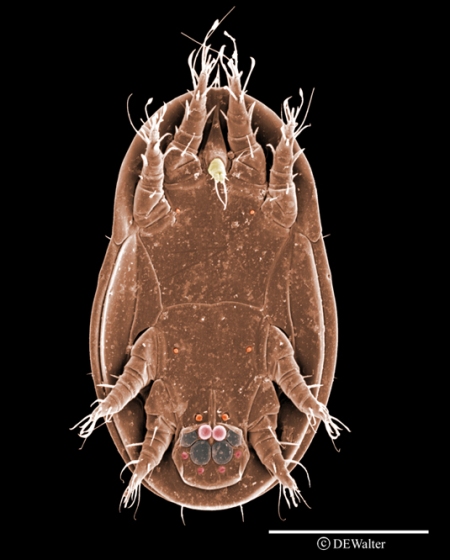
5 hypopi hitching a ride on an Athiasiella
This morning Myrmecos Blog, the place to go for spectacular ant pictures, links to a picture on Flickr by Brian Valentine of a couple of red ants from a compost heap covered with mites. I especially like the ones sticking to the foreground ant’s eye. These look like the dispersal stage of another Astigmatina, possibly a species of the acarid genus Sancassania, as they are common in decomposing material, but then so are several other families. If the compost is very wet and stinky, then they may be Histiostomatidae. The dispersal stages are technically called ‘heteromorphic deutonymphs’, but an older term ‘hypopus’ (plural – hypopi) is easier on the tongue. Hypopi are bizarre for a number of reasons. For example, most have some of their posterior ventral setae modified into a sucker plate that allows them to latch onto surfaces such as insect cuticle – or that of larger mites for that matter. Actually anthing with an appropriate surface that wanders through a compost heap can become covered with [these] little hitchhikers – the famous Australian medical acarologist, Bob Domorow, once published a picture in Acarologia of a skink absolutely encased in [hypopi] CORRECTION – deutonymphs, yes, but of a uropodid mite, not astigmatine hypopi. See Domrow, R. 1981. A small lizard stifled by phoretic deutonymphal mites (Uropodina). Acarologia 22:247–52

- Hypopus underside – note tiny ‘head’ and sucker plate (bottom)
.
Tags: phoresy
January 10, 2011 at 11:01 am |
[…] (image via: macromite) […]
February 28, 2011 at 12:39 pm |
[…] thief or kind of bee), but phoresy actually requires an absence of movement and it is usually not (but not always) the mite that does the carrying. Thus, the usage is a bit inverted from similarly derived jargon, […]
June 27, 2013 at 12:46 am |
[…] (image via: macromite) […]
July 30, 2013 at 8:26 am |
[…] (image via: macromite) […]